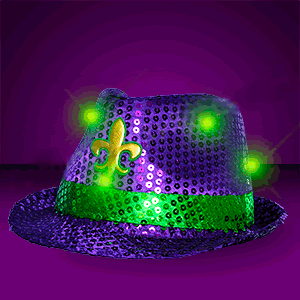Beginner’s Guide to Mardi Gras in New Orleans in 2023

What‘s New Orleans Mardi Gras like?
All tourists ever hear about Mardi Gras is Beads, Boobs, and Booze!
However there is much more to Mardi Gras than beautiful babes baring there breasts on Bourbon Street.
New Orleans Mardi Gras is not just a spurt of especially debauched frolicking. it’s an full compliment of celebrations, friendship, and partying. It is a weeks long festival of fun for natives and visitors alike.
There is some truth to the preconceived notions. There are plenty of beads, lots of drinking all around the city and on the beaches of the Gulf of Mexico, and plenty boobies on Bourbon Street.
What you don’t hear about as much are the backyard barbecues, block parties, and incredible costumes borne of fantasy in all sizes and shapes. Then there are more parades than could be counted, some of them even more peculiar than what is portrayed by the media.
New Orleans Mardi Gras is an artistic experience without rival. I’m giving you the benefit of my experience of New Orleans Mardi Gras in this guide so you can get the most out of it should you decide to attend.

What is the date and duration of Mardi Gras?
Mardi Gras season is actually about a month long, although most folks just think of one day: the Tuesday before Lent.
Epiphany is January 6 each year. It is the true beginning of the Mardi Gras Carnival season. This is the time the bakeries begin to sell King cakes, the home owners begin to decorate with blossoms and massive drinking gets underway.
There are a couple large parades to attend during the off season of Mardi Gras. These occur weeks before the big day. It may be a better option to attend these earlier parades to avoid crowds and additional expense.
The closer the city gets to Mardi Gras Fat Tuesday, the more parades get fired up. By the time of the big day, there are several parades a day.
The actual date of Fat Tuesday changes from year to year, so make sure you know when to go.
Here’s a list of the dates for upcoming years. Remember, Mardi Gras Fat Tuesday will most likely be on a Tuesday in February or March:
- 2021: February 16
- 2022: March 1
- 2023: February 21
- 2024: February 13

Your New Orleans Mardi Gras Journey
As soon as you set your mind to attend Mardi Gras, make sure to secure your airline reservation ASAP. The early bird gets the worm, and in this case that means you’ll get a much better deal on flights if you plan ahead. You’ll want to save your money for all the fun to be had.
Likewise, New Orleans accommodations fill up fast so early reservationists will be rewarded with much better deals. Don’t wait until you arrive in New Orleans to book a room
There are many neighborhoods better than the French Quarter for your stay. Avoid the extra chaos while remaining close to the parade action by trying these great neighborhoods:
- The Marigny: This is a very cute neighborhood adjacent to the French Quarter and within a short walk of Frenchmen Street.
- Uptown or the Garden District: Magazine and St. Charles streets are home to a plethora of parades. So staying in the uptown or garden districts will keep you close to the action, but away from the Quarter craziness. Plus you’ll have the benefit of plenty of shops and restaurants in this locale.

Crazy Costuming: what to bring to New Orleans Mardi Gras
Mardi Gras is like Halloween on steroids, so go all out. Of course you could wear lots of purple, yellow and green, but don’t let those colors limit your ensemble. Its time to go HAM! Go Cray! Be wild and absurd.
A fanny pack or small bag is a must-have. and of course you’ll want a crazy wig, and body glitter. Dress warm in layers. You don’t want to catch a cold in a chilly New Orleans February. Stick with functional footwear and comfortable kicks. Ill fitting shiny shoes will tire out your feet fast.

Lent lingo: Mardi Gras terms you should know
Here is a list of important terms associated with Mardi Gras
- Mardi Gras: “Fat Tuesday” in French.
- Krewe: A themed parade group. There are hundreds—if not thousands—in New Orleans. Namesake krewes of large parades are often made up of many smaller sub-krewes.
- Throw: Stuff thrown from parade floats. Can be anything from plastic beads to handmade statues to LED swords.
- Balls: Ticketed parties held by krewes to raise money. Some are swanky, some are wacky. Some are easy to get into, other more popular balls sell out quickly.
- Lent: A Christian 40-day period of fasting beginning the Wednesday after Mardi Gras.
- King cake: A sweet breaded cake usually topped with icing and sprinkles sold only during carnival season. Traditionally contains a tiny plastic baby; the person who gets the baby in their slice must buy the next cake!
Mardi Gras Krewes
According to Wikipedia, a Mardi Krewe is:
A krewe (pronounced “crew”) is a social organization that puts on a parade or ball for the Carnival season. The term is best known for its association with Mardi Gras celebrations in New Orleans, but is also used in other Carnival celebrations around the Gulf of Mexico, such as the Gasparilla Pirate Festival in Tampa, Florida, Springtime Tallahassee, and Krewe of Amalee in DeLand, Fl with the Mardi Gras on Mainstreet Parade as well as in La Crosse, Wisconsin[1] and at the Saint Paul Winter Carnival.
Here are a few important krewes you should be familiar with:
With his grand traditions, rich and colorful themes, elaborate costumes and hand-painted floats, Rex is the King of Carnival.
Rex, officially the School of Design, has held more parades than any other organization. They are the origin of many Mardi Gras traditions, including the official Carnival colors of purple, green and gold, as well as the collectible doubloon coins (introduced by Rex in 1960). The Krewe consists of 600 male riders and parades on the New Orleans Uptown route on Mardi Gras day, immediately after Zulu.
Endymion, Orpheus, and Bacchus are the three “super krewes” of Mardi Gras. They’re the oldest and certainly some of the biggest krewes in the city. Their parades roll during the final days of the Mardi Gras season/on Mardi Gras itself.
The Zulu organization is proud of its standing in the local community, but also takes pride in its national and international standing. The Zulu organization has been the subject of numerous television documentaries and newsprint and magazine articles. King Zulu 1949, Louis Armstrong, graced the pages of Time Magazine that year. Essence devoted a full half-hour segment of their weekly television series to Zulu’s impact on Carnival. Hordes of feature stories and photo essays have been done by international publications.
The Krewe of Muses is distinguished as the first all-female Mardi Gras krewe to parade at night uptown New Orleans. In Greek mythology, the Muses are the nine daughters of Zeus. No festivity in Olympus was considered complete without their joy-inspiring presence, and on earth no fine art, scientific, or intellectual endeavor was undertaken without humbly seeking their inspiration.
The Krewe du Vieux (KdV) was founded in 1987, born from the ashes of the fabled Krewe of Clones. The Clones began in 1978, based out of the Contemporary Arts Center. This “Art Parade” became wildly popular for their imaginative and creative street performance art. By 1985, the Krewe of Clones had grown to 30 subkrewes and over 1500 marchers.


